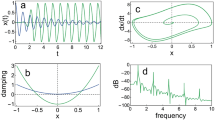Abstract
This paper presents an electronic system thatextracts the periodicity of a sound. It uses threeanalog VLSI building blocks: a silicon cochlea, twoInner Hair Cell circuits and two spiking neuron chips.The silicon cochlea consists of a cascade of filterswhich delays (and filters) the input sound as it passesalong the cascade. The time delay added by each individual filter in the cochlea increasesexponentially with position of the filter along thecochlea. The frequency for which the time delaybetween two outputs that are n-stages apart correspondsto a phase delay of 2π therefore decreases exponentially along the cochlea. In the systempresented in this paper we create spike trains from theoutput of the cochlear filters and we compare theoutput of each filter with the output of a filter foursections earlier in the cascade. If the signalfrequency corresponds to the inverse of the time delaybetween these two filters, then the two spikes in the spike trains created at these two outputs willcoincide. Detecting these coincidences can yield veryselective filters, i.e., filters that respond only toa very narrow range of periodicities, but that at thesame time still respond after a few periods of theinput signal. This is an advantage over traditionalband-pass filters, where an increase in selectivityhas to be traded off against decrease in responsetime.
Similar content being viewed by others
References
Palmer, A. R. and Russell, I. J., “Phase locking in the cochlear nerve of the guinea pig and its relation to the receptor potential of inner hair cells.” Hearing Research, 24, pp. 1-15, 1986.
Evans, E. F., “Functional anatomy of the auditory system,” in Barlowand Mollon (editors), The Senses. Cambridge University Press, Cambridge, pp. 251-306, 1982.
Rose, J. E., Hind, J. E., Anderson, D. J. and Brugge, J. F., “Some effects of stimulus intensity on response of auditory nerve fibers in the squirrel monkey.” Journal of Neurophysiology, 34, pp. 685-699, 1971.
van Schaik, A., Fragnière, E. and Vittoz, E., “Improved silicon cochlea using compatible lateral bipolar transistors.” Advances in Neural Information Processing Systems 8, edited by D.Touretzky, et al., MIT Press, Cambridge, MA, pp. 671-677, 1996.
Watts, L., Kerns, D. A., Lyon, R. F. and Mead, C. A., “Improved implementation of the silicon cochlea.” IEEE Journal of Solid-State Circuits, SC-27, pp. 692-700, 1992.
Lyon, R. F. and Mead, C. A., “An analog electronic cochlea.” IEEE Transactions on Acoustics., Speech and Signal Processing, 36, pp. 1119-1134, 1988.
Mead, C. A., Analog VLSI and Neural Systems. Addison-Wesley, Reading, MA, 1989.
Vittoz, E., “The design of high-performance analog circuits on digital CMOS chips.” IEEE Journal of Solid-State Circuits, SC-20, pp. 657-665, 1985.
Vittoz, E., “MOS transistors operated in the lateral bipolar mode and their application in CMOS technology.” IEEE Journal of. Solid-State Circuits, SC-24, pp. 273-279, 1983.
Arreguit, X., Compatible Lateral Bipolar Transistors in CMOS Technology: Model and Applications, Ph.D. thesis. Ecole Polytechnique Fèdèrale, Lausanne, 1989.
Rhode, W. S., “Observation of the vibration of the basilar membrane in squirrel monkeys using the Mossbauer technique.” Journal of the Acoustical Society of America, 49, pp. 1218-1231, 1971.
von Békésy, G., Experiments in Hearing. McGraw-Hill, 1960.
Hudspeth, A. J. and Corey, D. P., “Sensitivity, polarity, and conductance change in the response of vertebrate hair cells to controlled mechanical stimuli.” Proceedings of the National Academy of Sciences of the USA, 74, pp. 2407-2411, 1977.
van Schaik, A., Fragnière, E. and Vittoz, E., “An Analogue Electronic Model of Ventral Cochlear Nucleus Neurons.” Proceedings of the Fifth International Conference on Microelectronics for Neural Networks and Fuzzy Systems; MicroNeuro'96. IEEE Computer Society Press, Los Alamitos CA, pp. 52-59, 1996.
Delgutte, B., “Speech coding in the auditory nerve: II. Processing schemes for vowel like sounds.” Journal of the Acoustical Society of America, 75(3), pp. 879-886, 1984.
Lyon, R. F., “Computational models of neural auditory processing,” in Proceedings 1984 IEEE ICASSP, San Diego, 1984.
Sachs, M. B. and Young, E. D., “Effects of nonlinearities on speech encoding in the auditory nerve.” Journal of the Acoustical Society of America, 68(3), pp. 858-875, 1980.
Seneff, S., “A joint synchrony/mean-rate model of auditory speech processing.” Journal of Phonetics, 16, pp. 55-76, 1988.
Deng, L., Geisler, C. D. and Greenberg, S., “A composite model of the auditory periphery for the processing of speech.” Journal of Phonetics, 16, pp. 93-108, 1988.
Ghitza, O., “Temporal non-place information in the auditorynerve firing patterns as a front end for speech recognition in a noisy environment.” Journal of Phonetics, 16, pp. 109-123, 1988.
Shamma, S., “The acoustic features of speech sounds in a model of auditory processing: vowels and voiceless fricatives.” Journal of Phonetics, 16, pp. 77-91, 1988.
Lazzaro, J., “A silicon model of an auditory neural representation of spectral shape.” IEEE Journal of Solid-State Circuits, 26(5), pp. 772-777, 1991.
Vittoz, E., “Analog VLSI signal processing: Why, where and how?” Analog Integrated Circuits and Signal Processing, pp. 27-44, July 1994.
Author information
Authors and Affiliations
Rights and permissions
About this article
Cite this article
Schaik, A. An Analog VLSI Model of Periodicity Extraction in the Human Auditory System. Analog Integrated Circuits and Signal Processing 26, 157–177 (2001). https://doi.org/10.1023/A:1011246301664
Issue Date:
DOI: https://doi.org/10.1023/A:1011246301664




